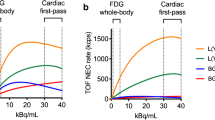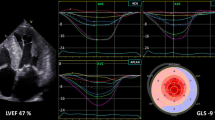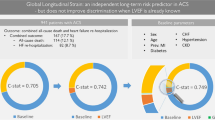Abstract
Background
The use of noninvasive diagnostics in coronary artery disease remains underdeveloped. To date, there is no simple and inexpensive method that can lead to a reliable diagnosis. Aside from costly and elaborate imaging techniques, exercise ECG, with its rather moderate sensitivity and specificity, is the main diagnostic method available.
Methods
In this prospective study of 109 patients, the diagnostic value of cardiogoniometry (CGM), a three-dimensional, computer-analyzed vector cardiogram, was determined before and after physical stress, and the results were compared with those obtained from a stress test. We also investigated whether the sensitivity and specificity of the classical bicycle stress test could be increased with the addition of measurements obtained by CGM. Coronary angiography was used as a reference method.
Results
CGM had a sensitivity of 39% at rest and 42% after physical stress and a specificity of 63% at rest and 57% after stress. This method was found to be markedly inferior to pre-test probability (sensitivity 53%, specificity 81%), stress ECG (sensitivity 52%, specificity 81%), and resting ECG (sensitivity 50%, specificity 64%). The efficiency of exercise ECG testing was not improved by use of CGM results.
Conclusion
If CGM is to be established as a viable diagnostic method in daily clinical practice, it must undergo further development.


Similar content being viewed by others
References
Bundesärztekammer (BÄK) (2014) Nationale VersorgungsLeitlinie Chronische KHK - Langfassung, 2. Auflage. Version 2. 2013 zuletzt verändert: 2014. http://www.leitlinien.de/mdb/downloads/nvl/khk/khk-2aufl-vers2-lang.pdf. Accessed Nov 13
Tunstall-Pedoe H, Kuulasmaa K, Mähönen M, Tolonen H, Ruokokoski E (1999) Contribution of trends in survival and coronar y-event rates to changes in coronary heart disease mortality: 10-year results from 37 WHO MONICA Project populations. Lancet 353(9164):1547–1557
Scottish Intercollegiate Guidelines Network (SIGN) (2014) Management of stable angina. (SIGN Guideline No 96). http://www.sign.ac.uk/pdf/sign96.pdf. Accessed Nov 27
Montalescot G, Sechtem U, Achenbach S, et al. (2013) ESC guidelines on the management of stable coronary artery disease: the Task Force on the management of stable coronary artery disease of the European Society of Cardiology. Eur Heart J 34(38):2949–3003. http://eurheartj.oxfordjournals.org/content/ehj/33/6/734.full.pdf. Accessed Nov 14
Gianrossi R, Detrano R, Mulvihill D et al (1989) Exercise-induced ST Depression in the diagnosis of coronary artery disease: a meta-analysis. Circulation 80(1):87–98 (Accessed 16 Jan 2015)
Brown KA (1991) Prognostic value of thallium-201 myocardial perfusion imaging. A diagnostic tool comes of age. Circulation. 83(2):363–381. http://ac.els-cdn.com/S0735109707022073/1-s2.0-S0735109707022073-main.pdf?_tid=9ce2ef84-7704-11e4-b55c-00000aab0f6b&acdnat=1417182422_874e6937c9b40d49b2768310142cf72c. Accessed 28 Nov 2014
Muhlestein JB, Lappé DL, Lima JA et al (2014) Effect of screening for coronary artery disease using CT angiography on mortality and cardiac events in high-risk patients with diabetes: the FACTOR-64 randomized clinical trial. JAMA 312(21):2234–2243
Opolski MP, Kim WK, Liebetrau C, Walther C, Blumenstein J, Gaede L, Kempfert J, Van Linden A, Walther T, Hamm CW, Möllmann H (2015) Diagnostic accuracy of computed tomography angiography for the detection of coronary artery disease in patients referred for transcatheter aortic valve implantation. Clin Res Cardiol 104(6):471–480. doi:10.1007/s00392-014-0806-z
Waha S de, Eitel I, Desch S et al (2013) Diagnostik und Therapie der chronischen Myokardischämie. Rolle der kardialen Magnetresonanztomographie. Herz 38(4):350–358
Buckert D, Kelle S, Buss S, Korosoglou G, Gebker R, Birkemeyer R, Rottbauer W, Katus H, Pieske B, Bernhardt P (2017) Left ventricular ejection fraction and presence of myocardial necrosis assessed by cardiac magnetic resonance imaging correctly risk stratify patients with stable coronary artery disease: a multi-center all-comers trial. Clin Res Cardiol 106:219
Hussain ST, Morton G, De Silva K, Jogiya R, Schuster A, Paul M, Perera D, Nagel E (2016) The assessment of ischaemic burden: validation of a functional jeopardy score against cardiovascular magnetic resonance perfusion imaging. Clin Res Cardiol. doi:10.1007/s00392-016-1047-0
Petrov G, Kelle S, Fleck E, Wellnhofer E (2015) Incremental cost-effectiveness of dobutamine stress cardiac magnetic resonance imaging in patients at intermediate risk for coronary artery disease. Clin Res Cardiol 104(5):401–409. doi:10.1007/s00392-014-0793-0
Becker M, Hundemer A, Zwicker C, Altiok E, Krohn T, Mottaghy FM, Lente C, Kelm M, Marx N, Hoffmann R (2015) Detection of coronary artery disease in postmenopausal women: the significance of integrated stress imaging tests in a 4-year prognostic study. Clin Res Cardiol 104(3):258–271. doi:10.1007/s00392-014-0780-5
Gibbons RJ (2003) ACC/AHA 2002 guideline update for the management of patients with chronic stable angina–summary article: a report of the american college of cardiology/american heart association task force on practice guidelines (Committee on the Management of Patients With Chronic Stable Angina) Circulation. 107(1):149–158. http://circ.ahajournals.org/content/107/1/149.full.pdf+html. Accessed 27 Nov 2014
Gensini GG (1980) Coronary arteriography. In: Braunwald E (ed) Heart disease, pp 352–353. 1980. Philadelphia
Härle T, Zeymer U, Hochadel M, Zahn R, Kerber S, Zrenner B, Schächinger V, Lauer B, Runde T, Elsässer A (2017) Real-world use of fractional flow reserve in Germany: results of the prospective ALKK coronary angiography and PCI registry. Clin Res Cardiol 106:140
Reith S, Battermann S, Hellmich M, Marx N, Burgmaier M (2014) Impact of type 2 diabetes mellitus and glucose control on fractional flow reserve measurements in intermediate grade coronary lesions. Clin Res Cardiol 103(3):191–201. doi:10.1007/s00392-013-0633-7
Poerner TC, Duderstadt C, Goebel B, Kretzschmar D, Figulla HR, Otto S (2017) Fractional flow reserve-guided coronary angioplasty using paclitaxel-coated balloons without stent implantation: feasibility, safety and 6-month results by angiography and optical coherence tomography. Clin Res Cardiol 106:18
De Bono D (1993) Complications of diagnostic cardiac catheterisation: results from 34,041 patients in the United Kingdom confidential enquiry into cardiac catheter complications. Br Heart J. 70(3):297–300. http://www.ncbi.nlm.nih.gov.pubmedmitsfx.han.med.uni-magdeburg.de/pmc/articles/PMC1025320/. Accessed 1 Dec 2014
Sanz E, Steger JP, Thie W (1983) Cardiogoniometry. Clin Cardiol 6(5):199–206
Saner H, Baur HR, Sanz E, Gurtner HP (1983) Cardiogoniometry: a new noninvasive method for detection of ischemic heart disease. Clin Cardiol 6(5):207–210
Sanz E, Kinser J (1984) Die Kardiogoniometrie als Methode zur Diagnose der KHK. Vergleichsstudie mit der Myokardszintigraphie. Schweizerische Rundschau für Medizin Praxis =. Revue suisse de médecine Praxis 73(39):1169–1173
Meier A, Höflin F, Herrmann HJ, Wolf C, Gurtner HP, Rösler H (1987) Comparative diagnostic value of a new computerized vectorcardiographic method (cardiogoniometry) and other noninvasive tests in medically treated patients with chest pain. Clin Cardiol 10(5):311–316
Vontobel H, Schmid JJ, Steinbrunn W (1988) Kardiogoniometrie nach E. Sanz. Schweizerische medizinische Wochenschrift 118(44):1603–1608
Schüpbach, Michael WM, Emese B, Loretan P et al (2008) Non-invasive diagnosis of coronary artery disease using cardiogoniometry performed at rest. Swiss Med Wkly 138(15–16):230–238
Vontobel H, Tartini R, Steinbrunn W (1988) Kardiogoniometrie bei koronarer Herzkrankheit. Eine klinische Studie. Schweizerische medizinische Wochenschrift 118(44):1609–1611
Huebner T, Schuepbach, Michael WM, Seeck A et al (2010) Cardiogoniometric parameters for detection of coronary artery disease at rest as a function of stenosis localization and distribution. Med Biol Eng Compu 48(5):435–446
enverdis GmbH—Medical Solutions. CGM BASICS: Eine Einführung in die Cardiogoniometrie. http://www.enverdis.com. Accessed 1 Dec 2014
Einecke D. Hohes Versorgungsniveau bei Herzkatheter-Untersuchungen - SpringerMedizin. [basierend auf Herbsttagung der Deutschen Gesellschaft für Kardiologie und Jahrestagung der Arbeitsgruppe Rhythmologie vom 9.-11. Oktober in Düsseldorf]. 2014. http://www.springermedizin.de/dgk-2014-herbst_aktuelle-daten-zeigen-herzkatheter-interventionen-sind-in-deutschland-gut-und-sicher/5367442.html?linktyp=teaser2&newsletterID=13&sendID=17980&cm_mmc=ecircleNL-_-LM_Update+Kardiologie-_-S_DGK+bezieht+Position%3A+Welche+Herzklappe+f%C3%BCr+welchen+Patienten%3F-_-L_18. Accessed 14 Nov 2014
Patel MR, Peterson ED, Dai D et al (2010) Low diagnostic yield of elective coronary angiography. New Engl J Med 362(10):886–895. http://www.ncbi.nlm.nih.gov.pubmedmitsfx.han.med.uni-magdeburg.de/pmc/articles/PMC3920593/pdf/nihms540259.pdf. Accessed 16 Jan 2015
Law MR, Wald NJ, Morris JK, Jordan RE (2003) Value of low dose combination treatment with blood pressure lowering drugs: analysis of 354 randomised trials. BMJ (Clin Res ed) 326(7404):1427. (Accessed 21 Jan 2015)
van den Hoogen PC, Feskens EJ, Nagelkerke NJ, Menotti A, Nissinen A, Kromhout D (2000) The relation between blood pressure and mortality due to coronary heart disease among men in different parts of the world. Seven Countries Study Research Group. N Engl J Med 342(1):1–8 (Accessed 21 Jan 2015)
Emond M, Mock MB, Davis KB et al (1994) Long-term survival of medically treated patients in the coronary artery surgery study (CASS) registry. Circulation 90(6):2645–2657. http://circ.ahajournals.org/content/90/6/2645.long. Accessed 26 Nov 2014
Vijan S (2004) Pharmacologic lipid-lowering therapy in type 2 diabetes mellitus: background paper for the American College of Physicians. Ann Intern Med. 140(8):650. http://annals.org/article.aspx?articleid=717379. Accessed 21 Jan 2015
Erdmann E (2011) Klinische Kardiologie: Krankheiten des Herzens, des Kreislaufs und der herznahen Gefäße. 8., vollständig überarbeitete und aktualisierte Auflage. Springer, Berlin. SpringerLink: Bücher
Seeck A, Garde A, Schuepbach M et al (2009) Diagnosis of ischemic heart disease with cardiogoniometry: linear discriminant analysis versus support vector machines. [4th European Conference of the International Federation for Medical and Biological Engineering 2008. Vander Sloten J, Verdonck P, Marc Nyssen M, Haueisen J.IFMBE]. Springer, Berlin
Sanz E, Schüpbach M (2009) Cardiogoniometry: a non-invasive electrocardiographic method to diagnose ischemic heart disease at rest. GMDS: Medizinische Informatik, Biometrie und Epidemiologie 5(3). http://www.egms.de/static/en/journals/mibe/2009-5/mibe000099.shtml#Abstract. Accessed 2 Dec 2014
Huebner T, Goernig M, Schuepbach M et al (2010) Electrocardiologic and related methods of non-invasive detection and risk stratification in myocardial ischemia: state of the art and perspectives. German Med Sci GMS e-J 8:Doc27
Acknowledgements
The manufacturer of the Goniometry Device, Enverdis GmbH, supported the study with the Goniometry device free of charge.
Author information
Authors and Affiliations
Corresponding author
Ethics declarations
Conflict of interest
The authors report no relationships that could be construed as a conflict of interest.
Rights and permissions
About this article
Cite this article
Weber, A., Smid, J., Luani, B. et al. Role of exercise cardiogoniometry in coronary artery disease diagnostics. Clin Res Cardiol 106, 573–581 (2017). https://doi.org/10.1007/s00392-017-1087-0
Received:
Accepted:
Published:
Issue Date:
DOI: https://doi.org/10.1007/s00392-017-1087-0




